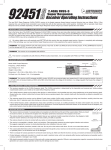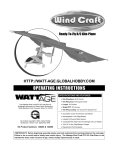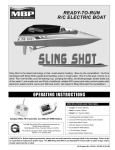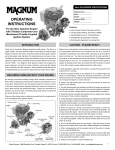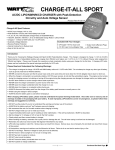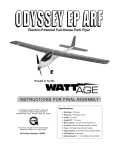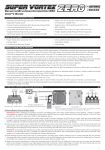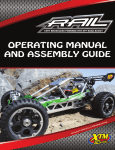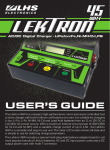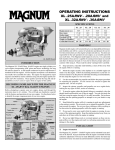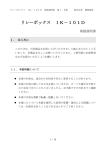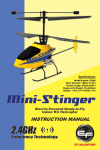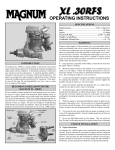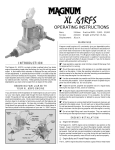Download XLS .52A - Hobby People
Transcript
XLS .52A AIRCRAFT ENGINE SPECIFICATIONS AND FEATURES XLS .52A AIRCRAFT ENGINE OPERATING INSTRUCTIONS P/N 210760 INTRODUCTION Thank you for choosing a Magnum XLS series aircraft engine. The XLS .52A is a single cylinder, two-stroke engine incorporating ABC (Aluminum piston, Chrome plated Brass sleeve) technology for long life, high power output and easy break-in. The engine features a dual needle valve carburetor with optional rear-mounted needle valve for precise fuel/airflow metering, dual ball bearing-supported crankshaft, dual bushing-supported connecting rod, and a high-flow quiet muffler. Your Magnum XLS series engine was designed by expert engineers and built by master craftsmen using only the highest quality materials and CNC machinery. These qualities provide the long life and dependability you have come to expect from an engine of this caliber. BECOMING FAMILIAR WITH YOUR ENGINE If you are familiar with the operation of two-stroke model engines or just can't wait to run your new engine, please read through the Quick-Start Guide included. The Quick-Start Guide will help you get started right away and also includes some good recommendations. We do recommend reading through these Operating Instructions in their entirety to familiarize yourself with the features and operation of your new engine. We have also included a Troubleshooting Guide should you encounter any problems. Please use the photos below to familiarize yourself with the components of your new Magnum XLS series engine. Displacement..................................................52ci (8.47cc) Bore / Stroke..................................................22.4mm / 21.5mm Practical RPM................................................2,200 - 18,000 Weight w/Muffler............................................17.4oz Crankshaft Thread Size.................................1/4-28 l ABC Piston and Sleeve l Dual Ball Bearing-Supported Crankshaft l Dual Bushing-Supported Connecting Rod l High-Flow Quiet Muffler for More Power l Rear-Mounted Needle Valve Option Included CAUTION - PLEASE READ BEFORE USE! Magnum XLS series model aircraft engines will consistently give you dependable performance and reliability and will be a source of satisfaction and pleasure if you follow these instructions as to the engine’s proper and safe use. You alone are responsible for the safe operation of your engine, so act sensibly and with care at all times. This Magnum XLS series model aircraft engine is not a toy. It is a precision-built machine whose power is capable of causing serious injury to yourself and others if abused or misused, or if you fail to observe proper safety precautions while using it. l Keep spectators, especially small children, at least 20 feet away from the engine while it is running. l Mount the engine securely in the aircraft or on a suitable engine test stand to run the engine. Follow the mounting instructions in your aircraft's instruction manual or on the plans for individual mounting recommendations. Do not clamp the engine in a vise to test-run it. l Use the recommended size propeller and follow the proper procedure for mounting the propeller. Use the correct size wrench to tighten the propeller nut. Do not use pliers. l Inspect the spinner, propeller, and propeller nut on a regular basis, looking for any signs of nicks, cracks or loosening. l To stop the engine, adjust the throttle linkage to completely close the throttle barrel and therefore cut off the fuel/air supply. You can also pinch the fuel line to stop the engine, but only if it is accessible. Do not throw anything into the spinning propeller or attempt to use your hands to stop the engine. l While the engine is running, stand behind the engine to make any adjustments to the needle valves. Do not reach over or around the propeller. Do not lean toward the engine. Do not wear loose clothing or allow anything to be drawn into the spinning propeller while the engine is running. l If you need to carry your model while the engine is running, be conscious of the spinning propeller. Keep the aircraft pointed away from you and others at all times. l Do not use a tight-fitting cowl over the engine. It can restrict air from flowing over the engine, which could result in engine damage from overheating. For proper cooling, the total cowl air-exit area should be 30% greater than the total air-intake area. *Due to running manufacturing changes and improvements, your engine may differ slightly from that shown. For product warranty information, please refer to the warranty card provided with your engine. Magnum XLS series engines are distributed exclusively by Global Hobby Distributors All contents copyright © 2009, Global Hobby Distributors, August 2009 ENGINE INSTALLATION Engine Orientation Your XLS series engine can be orientated in any position on the firewall. Keep in mind that when the engine is mounted inverted, carburetor adjustments will need to be made differently and the fuel tank may need to be lowered. (See fuel tank size and orientation to carburetor on the next page.) Global Services l 18480 Bandilier Circle l Fountain Valley, CA 92708 l Phone: (714) 963-0329 l Fax: (714) 964-6236 l Email: [email protected] 1 Engine Bolts and Firewall Requirements Rear Needle Valve Assembly Installation - Optional The engine should be mounted to either a glass-filled nylon engine mount, a machined aluminum engine mount, or an integrated hardwood beam mount. Use only high-quality 6-32 or 4mm steel socket-cap screws and related hardware to mount the engine to the engine mount. The firewall in the aircraft should be aircraft grade 5-ply plywood no less than 1/4" thick and the firewall should be reinforced to meet the torque and weight of the engine. Your XLS Series engine comes with the needle valve preinstalled in the carburetor. Also included is a rear needle valve assembly which can be installed in place of the carburetor mounted needle valve assembly. By using the rear needle valve assembly, adjusting the needle valve is safer because it's further behind the spinning propeller. Fuel Tank Size and Orientation to Carburetor Ideally, the stopper in the fuel tank should be level with the high speed needle valve or just slightly below it. Some models will only allow the fuel tank to be mounted higher than the ideal location. A fuel tank that is positioned higher than the ideal location usually doesn’t pose any problem except when it is mounted excessively higher and/or is used in conjunction with an inverted mounted engine or during extreme aerobatic flight. If you mount the engine inverted, we strongly suggest lowering the fuel tank so the stopper assembly is slightly below the high speed needle valve. Doing this will prevent fuel from siphoning into the engine and flooding it. If you cannot lower the fuel tank far enough, we suggest lowering it as far as can be allowed in your particular application. The size of the fuel tank used should be 10oz.~12oz., depending on the model and the length of flights desired. Use of a 12oz. tank will provide approximately 15 minutes of run time at full throttle. Use of a fuel tank any larger than 12oz. can lead to excessive leaning of the engine during flight and is not recommended. Carburetor Installation The carburetor is held in place using two socket-cap screws provided. Slide the base of the carburetor into the crankcase, being careful to keep the carburetor perpendicular to the front of the engine. Using your thumb, push down firmly on the carburetor so that the base of the carburetor sets completely into the crankcase. An o-ring is installed on the carburetor throat to seal the joint. While holding the carburetor firmly down into place, install and GENTLY tighten the socket-cap screws using the hex wrench provided. WARNING Do not overtighten the socket-cap screws or you might strip the threads in the carburetor, resulting in replacement of the carburetor. Muffler Installation The muffler is mounted to the engine using the two socket-cap screws, two split washers and one of the two gaskets provided. The second gasket should be kept as a spare. Tighten both screws firmly to prevent the muffler from loosening during flight. The exhaust cone on the back of the muffler can be adjusted to better match the installation of your particular application. To adjust the exhaust cone, loosen the retaining nut, rotate the cone to the desired angle, then tighten the retaining nut firmly while holding the axial bolt in place from the front of the muffler. It is important to tighten the retaining nut firmly to prevent the exhaust cone from loosening during flight. 2 To mount the rear needle valve assembly, use an adjustable wrench to unscrew and remove the needle valve assembly from the carburetor and to unscrew and remove the plug from the rear needle valve mount. Carefully thread the needle valve assembly into the rear needle valve mount and tighten it firmly, then carefully thread the plug into the carburetor and tighten it firmly. Remove the two upper backplate mounting screws, then install and tighten the two longer socket-cap screws and split washers (included with the rear needle valve assembly) to secure the rear needle valve assembly to the engine backplate. Connect the length of fuel tubing provided between the chrome fuel nipples on the rear needle valve assembly and the carburetor. The fuel pick-up line from your fuel tank should be connected to the larger brass nipple on the rear needle valve assembly. Carburetor Idle Stop Screw and Adjusting the Idle Speed The idle stop screw holds the throttle barrel in the carburetor body and also adjusts the closure of the throttle barrel. We recommend adjusting the idle stop screw to allow the throttle barrel to close completely. This will allow you to adjust the idle speed via your transmitter; therefore, you will need to set up your transmitter throttle trim lever to keep the engine at a low idle when the trim lever is centered, then to shut off the engine when the trim lever is pulled all the way back. To adjust the idle stop screw, first loosen the hex nut using an adjustable wrench, then loosen the idle stop screw (turn counter-clockwise) to allow throttle barrel to close more, or tighten the idle stop screw (turn clockwise) to make the throttle barrel stay open more. When satisfied with the adjustment, tighten the hex nut firmly. Throttle Arm Position The throttle arm angle can be adjusted to better suit your particular application. Using a 1.5 hex wrench, loosen grub screw in the side of the throttle arm, then adjust the angle of the throttle arm either forward or backward, and firmly tighten the grub screw. Needle Valve Extension If an extension is required to adjust the high speed needle valve, use a 1.5mm diameter wire of the necessary length (not included). Loosen the grub screw in the side of the needle valve using a 1.5mm hex wrench, insert the wire into the end of the needle valve, then tighten the grub screw firmly. Propeller Installation WARNING Before installing the propeller it must be balanced. Running your engine using an out-of-balance propeller can lead to excessive vibration, which will result in excessive stress and wear on both the engine and the airframe. Balance the propeller using the method recommended by the propeller manufacturer. Several products are available to properly balance propellers. Ask your local retailer for more information about these items. Global Services l 18480 Bandilier Circle l Fountain Valley, CA 92708 l Phone: (714) 963-0329 l Fax: (714) 964-6236 l Email: [email protected] Using a 1/4" drill bit or a propeller reamer, enlarge the hole in the propeller hub to fit the crankshaft. Slide the propeller onto the crankshaft, up against the drive washer, then slide the propeller washer up against the propeller and thread the propeller nut into place. Tighten the propeller nut firmly to secure the propeller into place. When tightening the propeller nut, use an adjustable wrench or a 4-way wrench. Do not use pliers. WARNING If you are installing a spinner onto your engine, the spinner cone must not rub against the propeller. Allowing the spinner cone to rub against the propeller could lead to propeller damage and eventual propeller failure. PROPELLER, GLOW PLUG AND FUEL Propeller Recommendation The diameter and pitch of the propeller needed for the XLS .52A engine will vary greatly depending on the application the engine is used in. The weight, drag, and the type of model and how you intend to fly it are all factors in determining the correct size propeller to use. Experimentation will be necessary to find the optimal size propeller for your particular application. Ideally you want a propeller that the engine will turn in the 10,000 - 15,000 rpm range on the ground, yet power the aircraft sufficiently. Using a propeller that is too small will cause the engine to run at too high an rpm. Using a propeller that is too large will cause the engine to run at too low an rpm, cause it to lug down too much and make tuning difficult. In both instances this can lead to premature engine wear and eventual failure. HIGH AND LOW SPEED NEEDLE VALVES High Speed Needle Valve The high speed needle valve is used to meter the air/fuel mixture at full throttle. Turn the needle valve clockwise to lean the mixture or turn the needle valve counterclockwise to richen the mixture. When you start the engine for the very first time the needle valve should be turned in completely, then backed out 2-1/2 turns. When you start the engine after that, leave the needle valve in the same position it was in when you shut down the engine. Low Speed Needle Valve The low speed needle valve is preset from the factory for initial starting and break-in. Do not adjust it until after the engine is broken in. The low speed needle valve regulates the air/fuel mixture at idle and during transition from idle to full throttle. Turn the needle valve clockwise to lean the mixture or turn the needle valve counterclockwise to richen the mixture. The low speed needle valve is preset from the factory, but minor adjustments may need to be made after the engine is broken in. To reset the low speed needle valve to the factory setting, follow these procedures: l Open the throttle barrel completely. While holding the throttle barrel open, turn the low speed needle valve clockwise GENTLY until it stops. From this point, while still holding the throttle barrel open, turn the low speed needle valve counter-clockwise 3 full turns. This is the factory setting. l WARNING It is possible to adjust the low speed needle valve so lean that the engine will not draw fuel. The low speed needle valve should not need to be adjusted more than one full turn in either direction from the factory setting. If the engine does not idle or transition, reset the low speed needle valve to the factory setting. Propeller Size Recommendations Use for Break-In 9x6 11 x 4 - 8 10 x 6 10 x 5 - 8 12 x 3 -6 STARTING PROCEDURE Your XLS series engine can be started using an electric starter or it can be started by hand. For safety and ease of starting, especially when the engine is new, we recommend using an electric starter. The following two procedures should be done with the power to the glow plug off. Glow Plug Recommendation Starting Using an Electric Starter Glow plugs can make a big difference in the performance of your engine. We recommend using a long-reach, hot heat-range glow plug intended specifically for high-performance two-stroke engines. Do not use a cold heat-range plug and do not use glow plugs that use an idle bar. This can lead to erratic engine runs, difficult tuning and eventual engine wear and failure. It's best to use an electric starter only when your engine as a spinner installed. Prior to use, make sure that the electric starter is turning counter-clockwise. When using an electric starter it is not necessary to prime the engine. The starter turns the engine over fast enough that the engine draws fuel on its own. Priming the engine prior to using an electric starter can cause the engine to hydro-lock (flood). Turning the engine over with an electric starter while the engine is flooded can cause extreme damage to the engine and/or cause the propeller assembly to come loose. Turn the propeller through the compression stroke one time by hand to check for a hydro-locked state before applying the starter. Fuel Recommendation Fuel can make a big difference in the way your engine performs. We recommend using a fuel containing 10%~20% nitro and 18%~20% castor oil/synthetic oil blend lubricant. The same fuel can be used for both break-in and normal running. Do not use a fuel containing less the 18% oil. IMPORTANT We highly recommend that the first gallon of fuel run through the engine contains either a castor oil/synthetic oil blend, or all castor oil. Do NOT use an all-synthetic oil fuel for the break-in period. After the first gallon of fuel, you can switch to an all-synthetic oil fuel, but only if the fuel is of high quality. For example, some 'sport' all-synthetic fuels use low-grade oils or oils with the wrong thermal properties (they do not transfer heat well), and do NOT work well in Magnum engines. If there is any question, it's always safe to use a castor oil/synthetic oil blended fuel, regardless of brand, as long as the oil content matches what is specified above. WARNING ABOUT ENGINE HYDRO-LOCKING If the engine becomes hydro-locked, do not force the propeller through the compression stroke. The excess fuel should be expelled from the engine. Completely close the high speed needle valve until it bottoms out, then remove the glow plug from the cylinder head. l l With a rag over the top of the engine, turn the crankshaft several times, using your electric starter or flipping the propeller by hand. The excess fuel will be expelled out of the engine and into the rag. l Check to make sure that the glow plug has not been fouled, then reinstall it and reset the high speed needle valve. Global Services l 18480 Bandilier Circle l Fountain Valley, CA 92708 l Phone: (714) 963-0329 l Fax: (714) 964-6236 l Email: [email protected] 3 Starting by Hand OPTIMIZING THE MIXTURE SETTINGS When starting the engine by hand always use a chicken stick or a heavy leather glove. Never just use your bare hand or serious injury could result. To make the engine easier to start by hand it should first be primed. This is done by opening the throttle barrel completely and covering the tip of the muffler with your finger. Fuel can then be drawn into the engine by 'pulling' the propeller through the compression stroke 2-3 times. This will draw fuel into the engine. After fuel begins to enter the carburetor, remove your finger from the muffler and pull the propeller through the compression stroke once to check for a hydro-locked condition. BREAK-IN PROCEDURE IMPORTANT Your XLS series engine is an ABC engine. The cylinder sleeve is tapered at the top, causing severe resistance when the piston moves through the top of the stroke. This is normal. When the engine heats up to operating temperature, this resistance will decrease and the proper clearance will be achieved. The break-in procedure will guide you through the steps necessary to properly break in your new ABC engine. The break-in process allows the engine parts to perfectly fit each other and properly protect each part from premature wear. The engine should be broken in using the type of fuel recommended in the Fuel Recommendation section on page 3. Fuel containing only synthetic lubricants should not be used during the break-in procedure. For the break-in procedure we recommend mounting the engine into the aircraft it will be used in. This way the muffler, fuel tank and throttle linkage can all be tested in combination with the engine. If your aircraft uses a cowl, it should be removed during the break-in procedure. WARNING Be careful never to lean the engine out too much. Remember that the lubricants for your engine are suspended in the fuel. If you lean out the fuel mixture too much you will also be lowering the amount of lubricant entering your engine. Less lubricant means more chance of your engine overheating and possible engine failure. Setting the High Speed Needle Valve q 1) Start the engine and remove the power from the glow plug. Allow the engine to warm up for about 30 seconds. q 2) After the engine has warmed up, slowly lean the high speed mixture until the engine reaches peak rpm. After reaching peak rpm, richen the mixture slightly until an audible drop in rpm is heard. If you are using a tachometer this should be between a 200~300 rpm drop. q 3) With the engine running at full power, carefully lift the nose of the aircraft about 45º into the air. The mixture should not become too lean, but you may hear a slight increase in rpm. If the engine sags, or loses rpm when you hold the nose up, the mixture is too lean. If this is the case, slightly richen the mixture and follow the test once more. IMPORTANT Rpm will increase about 10%~30% in the air. This is due to the forward motion of the aircraft as it is flying. Because of this, more air is entering the carburetor, at a higher force, which causes the mixture to lean out. Additionally, as the fuel level in the fuel tank goes down, fuel draw becomes more difficult for the engine, especially during aerobatics, thus causing the mixture to go lean. It is imperative that you set the mixture rich while on the ground to compensate for the leaning tendencies that will happen in the air. Always watch the exhaust during your flight. The engine should leave a noticeable white smoke trail at all times. If there is no smoke trail, the engine is running too lean. You should land immediately and reset the mixture. q 1) Turn the high speed needle valve out 2-1/2 turns from the fully closed position. q 2) If you are using an electric starter to start the engine, follow the procedure in the previous section on page 3. If you are starting the engine by hand, follow that procedure in the previous section above. q 3) Open the throttle barrel to approximately 1/4 throttle, then connect the power to the glow plug. Start the engine using an electric starter or by hand. If starting by hand you will need to vigorously flip the propeller through the compression stroke several times before the engine will start. q 4) Once the engine starts, open the throttle barrel to about 1/2 throttle. You may need to lean the high speed needle valve in about 1/4 turn to keep the engine running at half throttle. q 5) After the engine has been running about 1 minute, remove the power from the glow plug and slowly advance the throttle barrel to full throttle. Adjust the high speed needle valve so that the engine is running very rich. You should notice excessive white smoke coming from the exhaust. Let the engine run for approximately 10 minutes then stop the engine. q 6) Let the engine cool for approximately 10 minutes then restart it. Set the high speed needle valve mixture to a slightly leaner setting, about 1/4 turn more in. Let the engine run for about 5 minutes at this setting, then stop the engine and let it cool for approximately 10 minutes. Setting the Low Speed Needle Valve q 1) Start the engine and lean out the high speed needle valve as per the previous steps. Close the throttle until the slowest reliable idle is reached. Allow the engine to idle for about 15~20 seconds. q 2) Quickly advance the throttle to full. If the engine just stops running as soon as the throttle is advanced, the idle mixture is too lean. With the engine stopped, richen the idle mixture about 1/8 of a turn. q 3) Repeat steps 1 and 2 until the engine will transition from idle to full throttle smoothly. Minor hesitation in the transition is normal. q 4) If you quickly advance the throttle from idle to full and the engine seems to be very rich during transition (i.e., lots of smoke coming from the exhaust), the mixture is too rich. With the engine stopped, lean the idle mixture about 1/8 of a turn. q 5) Repeat steps 1 and 4 until the engine will transition from idle to full throttle smoothly. Minor hesitation in the transition is normal. BASIC ENGINE MAINTENANCE Avoid running the engine under dusty conditions. If you are in a dusty environment we suggest using an air filter over the carburetor. l q 7) Repeat the procedure in step 6, while leaning the needle valve slightly more each time. In all, you should run the engine about a total of 45 minutes of actual running time. After 45 minutes of run-time the engine is ready for flight. Fly the aircraft with the engine set as rich as possible, but with adequate power to fly the aircraft. After each flight, lean the mixture slightly. Continue to do this for about 5 flights. At this point the engine should hold a good setting on the high speed needle valve and you can begin to fine tune the needle valve settings to increase performance. 4 At the end of every flying day, purge the engine of fuel by disconnecting the fuel line and allowing the engine to run dry of fuel. l Use a high quality after-run oil in the engine after you have purged the engine of fuel. Inject the oil into the engine through the carburetor and through the glow plug hole. Rotate the crankshaft several times to distribute the oil throughout the engine. This will prevent the engine from forming rust. l Global Services l 18480 Bandilier Circle l Fountain Valley, CA 92708 l Phone: (714) 963-0329 l Fax: (714) 964-6236 l Email: [email protected] XLS .52A AIRCRAFT ENGINE QUICK-START GUIDE The following information is provided to get your new Magnum XLS series engine running right away with minimal effort. We have listed our recommendations for fuel, propeller, starting procedures and other recommended accessories. Also included is general information about the accessories needed for the engine that we hope you will find helpful. This Quick-Start Guide should not be used as a replacement for the Operating Instructions included; rather, it should be used along with the Operating Instructions. We highly recommend reading through the Operating Instructions to familiarize yourself with each part of the engine, along with the proper procedures for engine break-in and tuning. OUR RECOMMENDATIONS QUICK-STARTING PROCEDURES The following items are recommended for use with your Magnum XLS series aircraft engine. These items are recommended for initial start-up and running. Please read through the Operating Instructions for further details. Engine Preparation Fuel: Power Master 15% 2-Stroke Premium Sport Fuel Blend for Break-In q 2) Install the muffler onto the engine using the hardware provided. The muffler cone can be rotated to better suit the installation in your model. Be sure to tighten the nut securely to prevent the muffler cone from loosening. and for Normal Use We suggest using Power Master brand fuels. Power Master fuel comes in many different nitromethane contents that can be used in your XLS series engine. Power Master fuels are blended using only high-quality nitromethane, methanol, castor oil and synthetic lubricants to provide high power output, along with easy starting and unmatched lubricating and heat dissipation qualities. Fuel Tank: Dubro 12oz. Fuel Tank (Product Number 412) Dubro fuel tanks are a perfect match for your XLS series engine. This size recommendation will give you about 10~15 minutes of run-time at full throttle. Dubro fuel tanks are possibly the easiest fuel tanks to assemble and maintain, and feature a chin at the base of the fuel tank that prevents the fuel tubing from kinking when installed in your aircraft. Glow Plug: Thunderbolt # 3 Glow Plug (Product Number 115559) The Thunderbolt # 3 glow plug is designed to be used in high-performance engines using fuels containing 10%~30% nitro content and in any environment. It is a ‘hot’ type of glow plug for easy starting, excellent transition and incredible top end. The glow plug is also very durable and able to withstand repeated use, day after day. Propeller: APC 10 x 6 Propeller (Product Number LP10060) We have found that XLS series engines run best using APC brand props. They are designed to be very efficient and run quiet at high rpm’s, and they are also durable. Use this size propeller to break in your engine, then change to the propeller that best suits your application. Use the guide in the Operating Instructions to help you find the right size propeller. Glow Starter: Magnum Glow Starter w/Meter (Product Number 237438) The Magnum glow starter is an excellent choice for heating the glow plug. It uses a Sub-C NiCD, includes a meter to determine the quality of your glow plug, and it also includes a charger to recharge the battery. It’s a very economical product to purchase and can be used with any engine that uses a glow plug. Engine Mount: Dave Brown Engine Mount (Product Number 4650) The Dave Brown engine mount is a glass-filled reinforced nylon mount that mounts to a plywood firewall in the model. It is lightweight, strong and easy to install. q 1) Mount the engine to the recommended engine mount. A wood beam mount built into the airframe would also be sufficient. q 3) Install a glow plug into the cylinder head, making sure to use the copper gasket provided with the glow plug. q 3) Install the propeller to the engine using the propeller nut and washer provided. Tighten the nut securely using an adjustable wrench. q 4) Connect the fuel lines from the fuel tank to the engine. The fuel pick-up line should be connected to the fuel nipple on the carburetor and the pressure line should be connected to the pressure nipple on the muffler. Engine Starting q 1) Carefully turn the high speed needle valve in completely until it stops, then turn the needle valve out 2-1/2 turns. This is the mixture setting for initial starting. IMPORTANT Do not adjust the low speed needle valve at this time. It’s factory-adjusted for the break-in process. q 2) If hand starting, prime the engine by opening the throttle barrel completely, placing your finger over the carburetor opening and flipping the propeller through compression 2~3 times. If you will be using an electric starter, do not prime the engine. The starter will turn the engine over fast enough to draw fuel on its own. q 3) Connect the glow starter to the glow plug. Open the throttle barrel to about 1/4 throttle and start the engine. If you are starting the engine by hand, you will need to vigorously flip the propeller several times before the engine will start. Once the engine begins running, immediately turn the high speed needle valve in about 1/4 turn to keep the engine running. q 4) Advance the throttle to full while turning the high speed needle valve in to keep the engine running. The engine should be producing a very noticeable white exhaust from the muffler and sound like it is running rough. Allow the engine to run only for about 5 minutes, then shut the engine off. q 5) Now that you have started your engine, it must be properly broken in. Proper break-in will seat all of the moving parts, particularly the piston and cylinder. This procedure takes about 20~30 minutes of run-time and is highly recommended. An engine that is properly broken in will produce more power, be more user-friendly and last much longer than an engine that does not receive a break-in period. For this reason we highly recommend following the break-in procedure detailed in the Operating Instructions before running the engine further. XLS .52A AIRCRAFT ENGINE TROUBLESHOOTING GUIDE This troubleshooting guide has been provided to help you diagnose and solve most problems that you may encounter with your XLS series engine. Most problems encountered can be solved by carefully following the problem-cause-solution sections below. If you cannot solve the problem using this troubleshooting guide, please feel free to contact us using the information below. Global Services 18480 Bandilier Circle Fountain Valley, CA 92708 Phone (714) 963-0329 Fax (714) 964-6236 Email: [email protected] For product warranty information, please refer to the warranty card provided with your engine. PROBLEM CAUSE SOLUTION 1) Engine does not start A) Failed glow plug A) Replace glow plug with new one B) Glow starter not charged and/or faulty B) Fully charge glow starter and/or replace C) Engine not being turned over fast enough C) Use an electric starter to start engine D) Low speed needle valve set too lean D) Reset low speed needle valve to factory setting E) Old or contaminated fuel E) Replace with new fuel F) Engine flooded with too much fuel F) Remove glow plug and expel fuel from cylinder G) Faulty fuel tank and/or stopper assembly G) Check and/or replace fuel tank assembly H) Air leak in fuel system and/or engine H) Replace fuel lines and/or tighten all engine bolts 2) Engine does not draw fuel A) Air leak in fuel system and/or engine A) Replace fuel lines and/or tighten all engine bolts B) High speed needle valve fully closed B) Reset high speed needle valve to factory setting C) Low speed needle valve set too lean C) Reset low speed needle valve to factory setting D) Fuel lines kinked D) Check and straighten fuel lines E) Defective fuel tank E) Replace fuel tank 3) Engine vibrates excessively A) Propeller out of balance A) Balance propeller B) Engine and/or engine mount loose B) Tighten engine mounting bolts 4) Engine does not transition A) Failed and/or wrong type glow plug A) Replace with new recommended glow plug B) Old and/or wrong type fuel B) Replace with new recommended fuel C) High speed needle valve set too rich C) Set high speed needle valve to leaner setting D) Low speed needle valve set too lean D) Set low speed needle valve richer E) Low speed needle valve set too rich E) Set low speed needle valve leaner F) Air leak in fuel system and/or engine F) Replace fuel lines and/or tighten all engine bolts G) Propeller too large G) Replace with one size smaller propeller 5) Throttle barrel does not A) Throttle servo linkage out of adjustment A) Adjust throttle linkage to close throttle barrel close completely B) Idle stop screw out of adjustment completely B) Turn idle stop screw counter-clockwise until throttle barrel closes fully C) Low speed needle valve set too lean C) Set low speed needle valve richer 6) Engine overheats A) Engine running too lean A) Richen high speed needle valve B) Cowl too restrictive B) Open larger vents in cowling to allow air to exit C) Wrong type of fuel used C) Use fuel with recommended oil content and type D) Engine not fully broken in D) Allow engine further break-in time 7) Engine stops abruptly A) Engine running too lean A) Richen high speed needle valve B) Piston and sleeve out of tolerances B) Return engine to Global Services C) Engine overheating C) See # 6 above D) Low speed needle valve set too lean D) Set low speed needle valve richer E) Failed glow plug E) Replace glow plug with new one F) Fuel tank empty F) Refill fuel tank 284220 284222 284221 281160 281242 281154 281244 282002 283023 281240 281799 281160 281720 281159 281155 284225 281798 281901 281166 284206 281903 280201 282452 281800 280110 280201 280713 281151 281154 281155 281159 281160 281163 281166 281168 281240 281242 281244 281245 281246 281265 281306 281420 281601 281715 281720 281798 281799 281800 281901 281903 282002 282004 282130 282159 282201 282310 282401 282412 282452 282501 282608 283022 283023 284206 284220 284221 284222 284223 284225 284226 284227 284228 284229 284230 284231 ORDER # 46609 40228 S52204 400160 S91225 S91109 40120 80841 91130 12862 46871F S40119 S40219 S40873F S40813 S40901 S40863 28123 40110 40134 120616 S40120 S15860 S15861 S40874F 12833 12847 12819 12114 46814A S32868F 46866 46810F 40816 40845 46845F 91137 46837F S40801F S40803F 12830 S52103X S52112 S52203 S52213 S52101 S52210 S52111 S52102 S52601X S52604X S52416 REFERENCE # Muffler Gasket Propeller Nut and Washer Connecting Rod Sleeve Index Pin Drive Washer Spacer Ball Bearing - Front Cylinder Head Mounting Bolts (6) Lock Washers (2) Lock Washer High Speed Needle Valve Seat - Complete Rear Needle Valve Mount Plug Carburetor Retaining Bolts (2) Drive Washer Rear Needle Valve Mount Only Throttle Barrel Bolt Set - Cylinder Head and Backplate Carburetor Body with Spray Bar Rear Needle Valve Mounting Bolts (2) Ball Bearing - Rear Backplate Mounting Bolts (4) Muffler Axial Bolt with Nut Muffler Mounting Bolts (2) High Speed Needle Valve Assembly - Complete High Speed Needle Valve with O-Ring Rear Needle Valve Assembly - Complete High Speed Needle Valve Detent Spring Needle Valve Seat/Plug Gasket Fuel Nipple with Gasket Fuel Nipple without Gasket Throttle Barrel Spring Carburetor Plug Throttle Arm Low Speed Needle Valve with O-Ring Carburetor Base O-Ring Low Speed Needle Valve O-Ring High Speed Needle Valve O-Ring Fiber Washer Idle Stop Screw with Nut Carburetor Assembly - Complete Carburetor and Rear Needle Valve Assemblies High Speed Needle Valve Seat Cylinder Head Cylinder Head Gaskets (2) Piston and Sleeve Set Wrist Pin and Retainer Set Crankcase Crankshaft Backplate Gasket Backplate Muffler - Complete Muffler Middle Gasket Set - Cylinder Head and Backplate DESCRIPTION XLS .52A AIRCRAFT ENGINE EXPLODED PARTS VIEW 281151 281240 282159 282501 281168 281265 281903 281246 280110 280713 Replacement parts can be ordered directly from your local Magnum engine hobby retailer. If your hobby retailer does not stock Magnum engines, you can order replacement parts direct from us. 281420 282002 284223 Global Services 18480 Bandilier Circle, Fountain Valley, CA 92708 281160 284228 282004 284226 281800 284230 282130 282310 282401 282608 281715 284227 Phone: (714) 963-0329 / Fax: (714) 964-6236 Email: [email protected] 281306 281160 281601 281715 281163 284229 284231 281245 282412 282201 283022 Revision 3 August 2009 XLS .52A AIRCRAFT ENGINE DIMENSIONAL DRAWING Use this drawing to help you determine engine mounting requirements. Drawing is not to scale and is generic in nature. XLS F E D C B A 1-1/8" 11/16" 3-1/2" 2-7/8" 4-3/4" 3-1/2" 3-3/8" N M L K J I H 7/16" 1-3/4" 1-7/16" 1-1/16" 2-1/16" 1-3/4" 1-7/16" DIMENSIONS G








